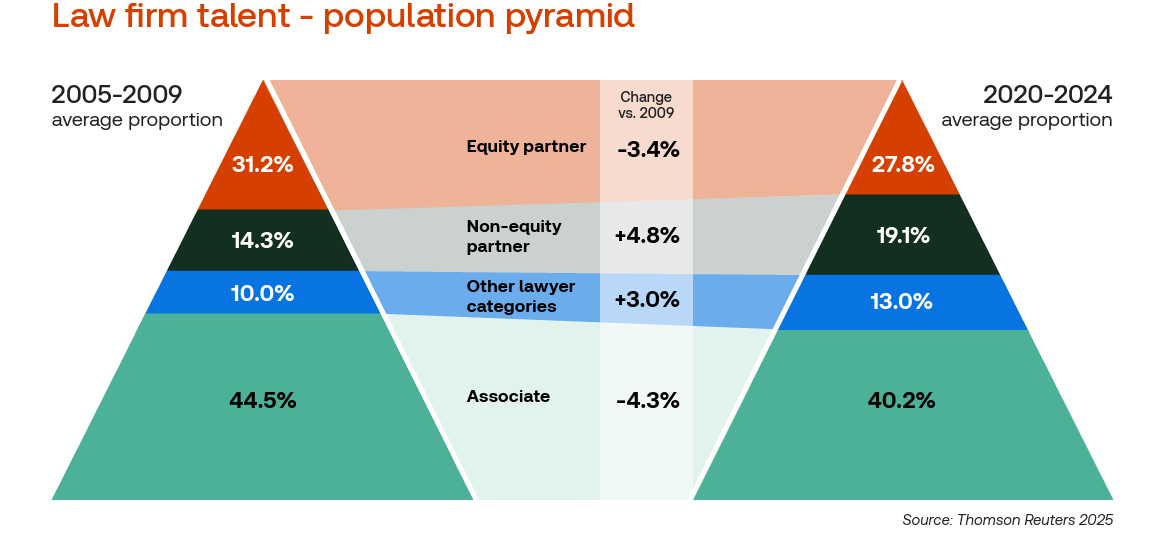As law firms look to potentially shrink associate class sizes and increase associate compensation, recruiting of new talent for in-house legal roles could become increasingly challenging
The legal market is at an interesting intersection in terms of talent recruiting and development. In fact, it’s perhaps less of a typical intersection and more of a massive roundabout with various interests flowing in and out.
Many law firms have begun to restructure their talent pyramid even before the effects of generative AI (GenAI) have really even begun to be felt.

Most common among these shifts have been reductions in equity partner and associate tiers. At the same time, many law firms have been doing their best to keep up with the seemingly ever-increasing associate pay scales. And even those law firms that don’t feel the need to pay absolute top dollar to their associates (particularly the more junior ones) have still felt the need to increase associate salaries to some degree in order to recruit and retain talent.
And all of this has occurred in advance of what many industry observers and commentators consider to be an inevitable change in law firm talent models catalyzed by broader adoption of GenAI technologies with an even greater capability to perform legal-related tasks. Many believe this will lead to even greater contraction of the associate ranks within law firms.
The result of this has been generally fewer associates than in past generations who are used to commanding higher salaries. These factors have combined to create a rather vexing problem for corporate law departments.
W(h)ither the in-house talent?
Lawyers working in-house for corporate law departments are feeling the pressure. The average in-house lawyer repots working a 49-hour work week, yet 6 in 10 say they don’t have enough time to accomplish everything they would like to do. At the same time, most corporate law departments report increasing matter volumes but flat to declining budgets and attorney headcount.
Clearly, in-house legal teams need some relief. The question is, where will it come from?
At a recent event hosted in collaboration with the Association of Corporate Counsel, several corporate general counsel (GCs) talked with me about the challenges they are having recruiting new in-house talent in today’s market. As noted above, law firms have been recruiting fewer associates on average. As a result, GCs who have followed the traditional recruiting path of looking for talent that is leaving law firms after gaining a few years of experience are finding a shrinking talent pool. And those lawyers who are looking to shift from a law firm to an in-house law department have very different salary expectations compared to those from even a few years ago, placing additional strain on already stretched corporate budgets.
At the same time, many in attendance at this event shared with me that the traditional argument in favor of better work-life balance by moving in-house is losing its effect. Many law firms have adopted more flexible working arrangements with some even allowing associates to tier themselves into varying billable hour requirements. In-house lawyers, on the other hand, often find themselves working longer hours for comparatively less overall compensation. And today’s challenges may only increase in the future.
That’s chiefly because GenAI will almost inevitably work its way more deeply into lawyer workflows. If those who think this will mean smaller associate classes for law firms are proven correct, the recruitment challenges faced by GCs today will likely compound. The already tight recruiting market will shrink further; and fewer first-year associates in today’s class ultimately will mean fewer third- or fifth-year associates later.
So what can be done?
The likelihood that GCs will find themselves in an even trickier recruiting position in just a few years seems quite high. There are, however, a few potential solutions.
As an obvious starting point, GCs may have to take a close look at increasing the starting salaries for their law firm recruits. This option, however, will be a difficult path given the already high degree of pressure placed on law department budgets. Indeed, 20% of corporate C-Suite officers already say that continuing to cut costs is a high priority.
Another option many GCs are considering is changing who they recruit. Rather than waiting until an attorney has put in several years of service at a law firm and established a set salary expectation, many GCs are strongly considering more aggressive recruitment directly out of law school. Historically, this option was viewed less favorably because the sweat equity required to teach a junior lawyer how to actually be a lawyer (as opposed to simply how to think and act like one) carried high time and cost commitments. However, now with the advent of better technology to assist and train inexperienced lawyers, the sweat equity required may be considerably less. And that shifts the calculus more in favor of GCs who are looking to recruit greener lawyers.
The ability to leverage better technology could also help strengthen the case for why law firm lawyers would want to move in-house. Many law firms are engaged in a race to be second by choosing to wait for GenAI and other advanced technologies to become more proven before making a serious move to adopt. For GCs willing to be more aggressive, and frankly to do more to meet their C-Suites’ desires to be among the early adopters of AI, this presents an opportunity.
Law firms have been recruiting fewer associates on average; and as a result, GCs who have followed the traditional recruiting path of looking for talent that is leaving law firms after gaining a few years of experience are finding a shrinking talent pool.
In 2022, the Thomson Reuters Institute released a study looking at how law firms compete for talent and what makes attorneys want to stay at a firm. That study found those lawyers more likely to stay at their current firm cited factors such as the firm’s direction and strategy as well as the support they received from their IT teams. Interestingly, these factors often were cited more than simply the amount of money they made. Moreover, firms that were more likely to retain their attorneys also tended to be classified as innovators or early adopters on a technology adoption scale. Significantly, quality of work — meaning the perceived quality of the work the attorneys were assigned — was cited more than twice as often as a reason lawyers were likely to stay at their current firms or that they liked about where they currently worked.
For GCs, this presents an opportunity. One of the best early use cases for GenAI is its ability to absorb lower-value work. This is the type of work that can often be viewed as less engaging and stimulating by the lawyers that have to do it. As more of that work is handled by GenAI, in-house lawyers will have an increased capacity for more engaging, higher-level work.
Indeed, a move toward faster adoption of evolving technologies could give GCs several needed results: i) It will help them address team capacity and budget pressure; ii) it will create additional capacity for the in-house team without having to hire a large number of new lawyers; and iii) it could help create an environment in which the quality of the work lawyers get increases, even if the number of hours worked does not vary that much, which could certainly boost the attractiveness of the in-house role.
The future of talent recruitment for GCs promises to be challenging, and law firms do not appear poised to make it any easier. However, by leveraging thoughtful strategies in the short-term, today’s GCs could help create more favorable outcomes for their departments down the road.
You can download a full copy of the Thomson Reuters Institute’s just-published 2025 State of the Corporate Law Department Report here







